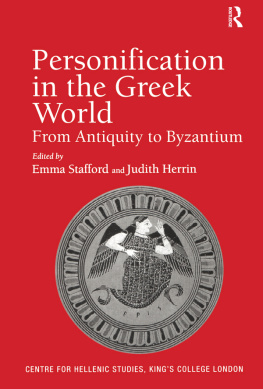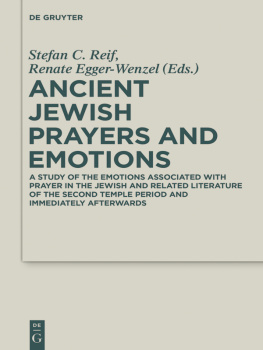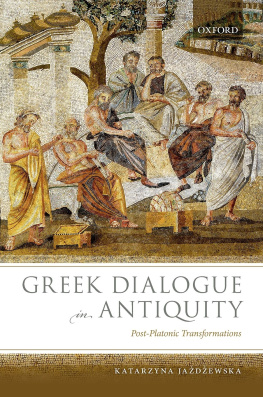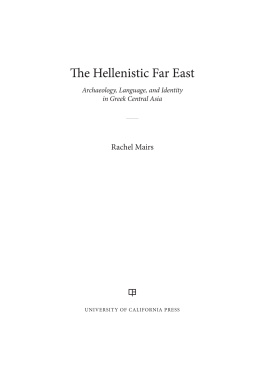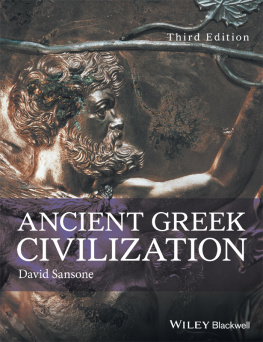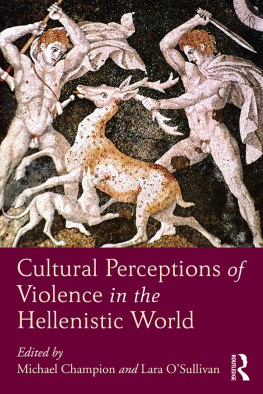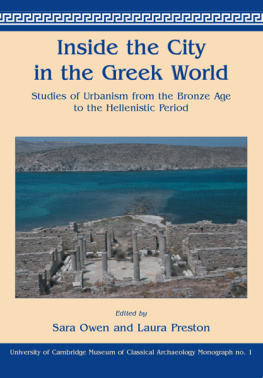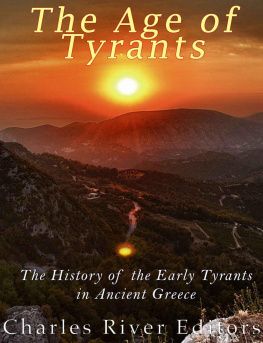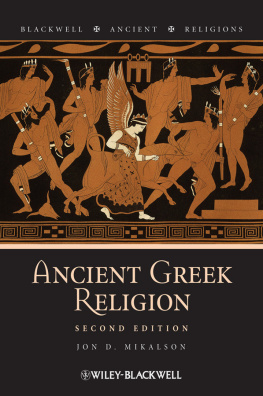PERSONIFICATION IN THE GREEK WORLD: FROM ANTIQUITY TO BYZANTIUM
Centre For Hellenic Studies
Kings College London
Publications 7 |  |
PERSONIFICATION IN THE GREEK WORLD:
From Antiquity to Byzantium
edited by
Emma Stafford and Judith Herrin
First published 2005 by Ashgate Publishing
Published 2017 by Routledge
2 Park Square, Milton Park, Abingdon, Oxon OX14 4RN
711 Third Avenue, New York, NY 10017, USA
Routledge is an imprint of the Taylor & Francis Group, an informa business
Copyright 2005 Emma Stafford and Judith Herrin
The editors have asserted their moral right under the Copyright, Designs and Patents Act, 1988, to be identified as the editors of this work.
All rights reserved. No part of this book may be reprinted or reproduced or utilised in any form or by any electronic, mechanical, or other means, now known or hereafter invented, including photocopying and recording, or in any information storage or retrieval system, without permission in writing from the publishers.
Notice:
Product or corporate names may be trademarks or registered trademarks, and are used only for identification and explanation without intent to infringe.
British Library Cataloguing in Publication Data
Personification in the Greek World: From Antiquity to Byzantium. (Publications for the Centre for Hellenic Studies, Kings College London; 7)
1. Greek literature Themes, motives. 2. Personification in literature. 3. Personification in art. 4. Mythology, Greek in literature. 5. Mythology, Greek in art. 6. Greece Religious life and customs. I. Stafford, Emma. II. Herrin Judith. III. Kings College, London. Centre for Hellenic Studies.
880.915
US Library of Congress Cataloging in Publication Data
Personification in the Greek World: From Antiquity to Byzantium/ edited by Emma Stafford and Judith Herrin.
p. cm. (Publications for the Centre for flellenie Studies, Kings College London; 7)
Includes biographical references.
1. Personification in art. 2. Arts, Greek. 3. Cults Greece History To 1500.
I. Stafford, Emma. II. Herrin, Judith. III. Series. IV. Publications (Kings College (University of London). Centre for Hellenic Studies); 7.
NX650.P48P47 2004
700.415dc22 2004016984
Typeset by W.M. Pank, Kings College London.
ISBN 13: 978-0-7546-5031-7 (hbk)
THE CENTRE FOR HELLENIC STUDIES,
KINGS COLLEGE LONDON, PUBLICATIONS 7
Contents
Walter Burkert
Naoko Yamagata
Eva Parisinou
Diana Burton
Kerasia Stratiki
Lucas Siomanes
Efthymios G. Lazongas
Nicolas Richer
Arlene Allan
Irina Kovaleva
Penelope Murray
Alan H. Sommerstein
Kristen Seaman
Barbara E. Borg
Amy C. Smith
Ruth Leader-Newby
Janet Huskinson
Yorgis Yatromanolakis
Iskra Gencheva-Mikami
Liz James
Elizabeth Jeffreys
Arlene Allan is Lecturer in Classics at the University of Otagar, having previously been Visiting Lecturer at Northwestern University (200102) and Assistant Professor at Trent University (200204). She held the Leventis Graduate Research scholarship at the University of Exeter from 19982001, successfully completing her PhD, The Lyre, The Whip and the Staffof Gold: Readings in the Homeric Hymn to Hermes, in 2003.
Barbara E. Borg is Lecturer in Classics at the University of Exeter, having previously been Hochschuldozentin at the Institute of Classical Archaeology at the University of Heidelberg, Germany. Among her major fields of interest are the iconography and the rhetorics of images, both Greek and Roman. The same interest guided her study of personifications, which is the subject of her Der Logos des Mythos: Allegorien und Personifikationen in der griechischenKunst (Munich 2002).
Walter Burkert has been Professor of Classics at the University of Zrich (196996) and visiting professor at Harvard, Berkeley and other universities in the USA. His research concentrates on ancient Greek philosophy and religion, their interrelation, oriental contacts, and perspectives of anthropology. His major publications include Loreand Science in Ancient Pythagoreanism (Harvard 1972), Structure and History in Greek Mythology and Ritual (Sather Lectures 1979), Greek Religion: Archaic and Classical (Harvard 1985), The Orientalizing Revolution (Harvard 1992), Creation of the Sacred: Tracks of Biology in Early Religions (Harvard 1996).
Diana Burton is Lecturer in Classics at Victoria University of Wellington. Her research interests centre around death and immortalisation in ancient Greek myth, and particularly the iconography of death-related figures. She is working on a book on the immortalisation of heroes in archaic Greek art and myth.
Iskra Gencheva-Mikami was Assistant and then Associate Professor in Roman History and Late Antiquity at the University of Sofia St. Climent Ohridski and the New Bulgarian University, Sofia (19932001). She is currently a visiting professor at the Department of Religious Studies, University of Tokyo, Japan. Among her main research interests and publications are various aspects of Roman imperial bureaucracy: bureaucracy and art, bureaucracy and religion, bureaucracy and politics. Her research on the Notitia dignitatum is connected with these major fields of interest.
Judith Herrin is Professor of Late Antique and Byzantine Studies at Kings College London. From 1995 to 2002 she was Director of the Centre for Hellenic Studies, KCL, which sponsors conferences such as the one devoted to Personification and publishes the proceedings. Her most recent book is Women in Purple. Rulers of Medieval Byzantium (2001) and she is currently working on an introductory study, a Byzantium for beginners.
Janet Huskinson is Senior Lecturer in the Department of Classical Studies at the Open University. Her research interests are in the art of Roman empire and its relationship with the society which produced and used it, and she has also written on sarcophagi and portrait sculpture.
Liz James is a Reader in the Department of Art History, University of Sussex, where she teaches Byzantine art. Her book, Empresses and Power in Early Byzantium (London 2001) looks at the representations of female power in Byzantium and she is interested in Ehe changing iconographies of empresses.
Elizabeth Jeffreys is Bywater and Sotheby Professor of Byzantine and Modern Greek Literature in the University of Oxford, and Fellow of Exeter College. She works on texts that are at the interface between spoken and written medieval Greek. Her recent publications include editions of the fourteenth-century War of Troy and the twelfth-century epic-romance Digenis Akritis.
Irina Kovaleva is Associate Professor of Classics at Moscow State Lomonosov University. She has been British Academy Visiting Scholar (1995) and Alexandros S. Onassis Public Benefit Foundation Scholar (1996). She has published over 70 essays on ancient Greek mythology, philosophy and literature, as well as on Modern Greek and Russian literature. Her PhD thesis was on

